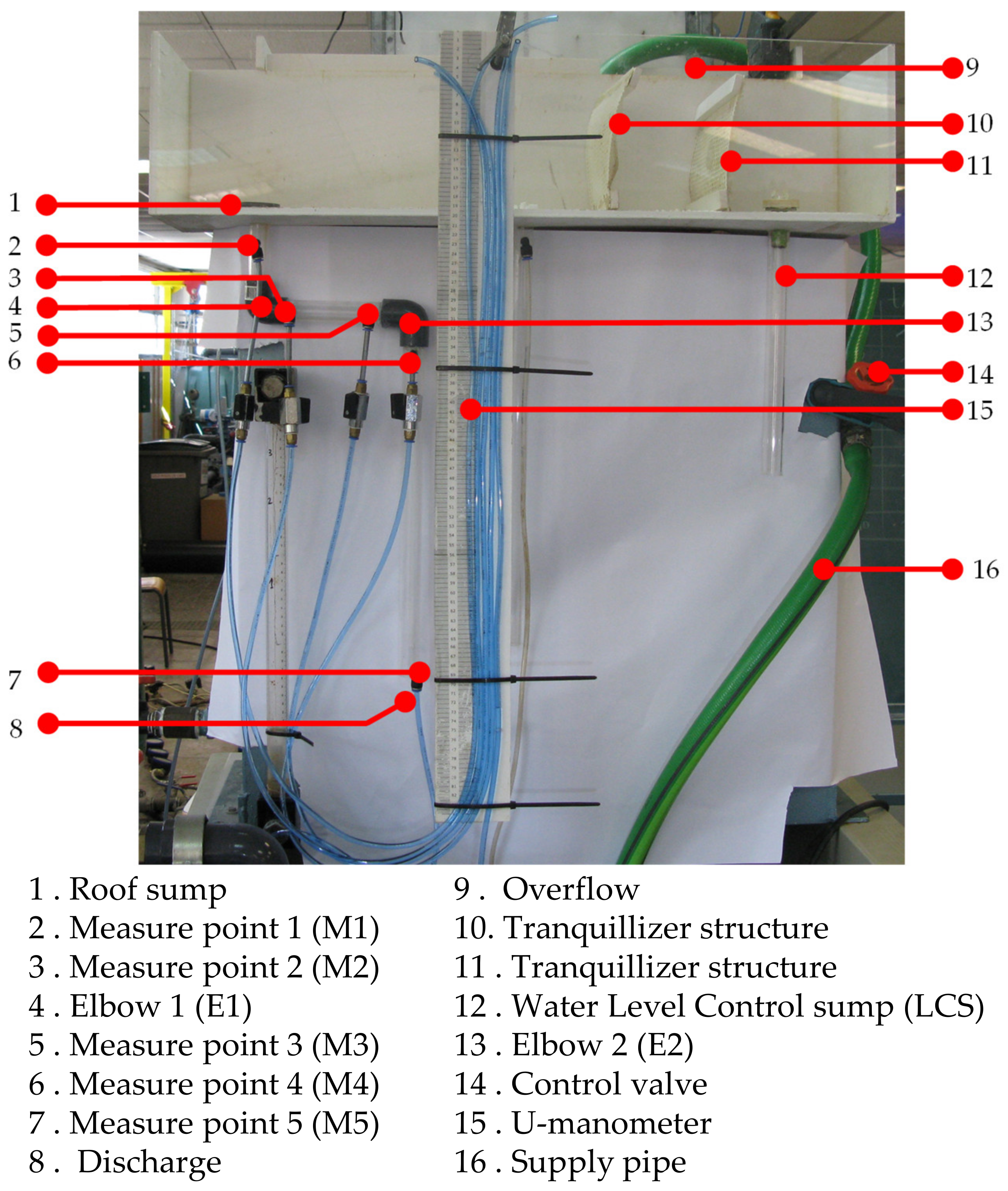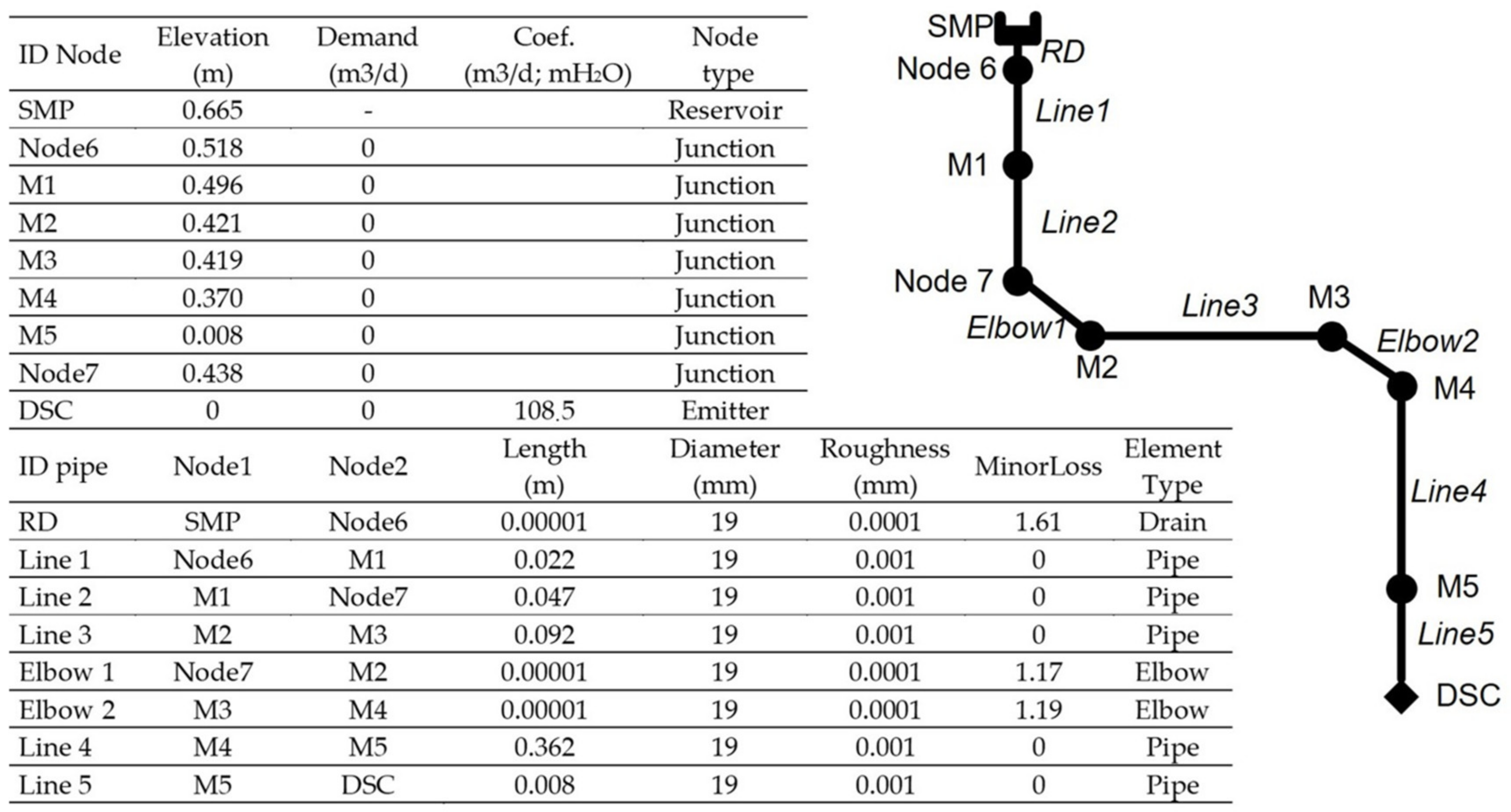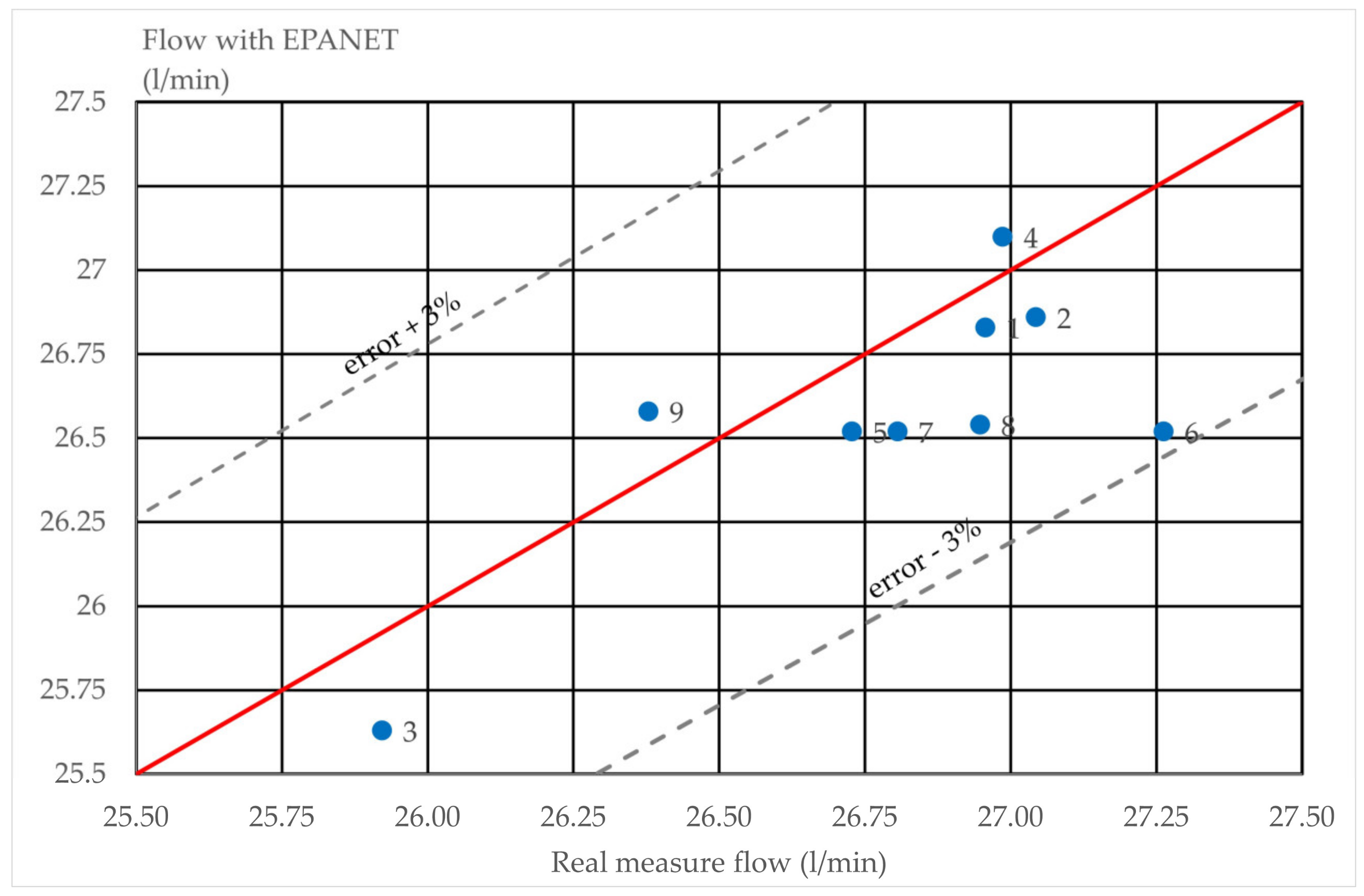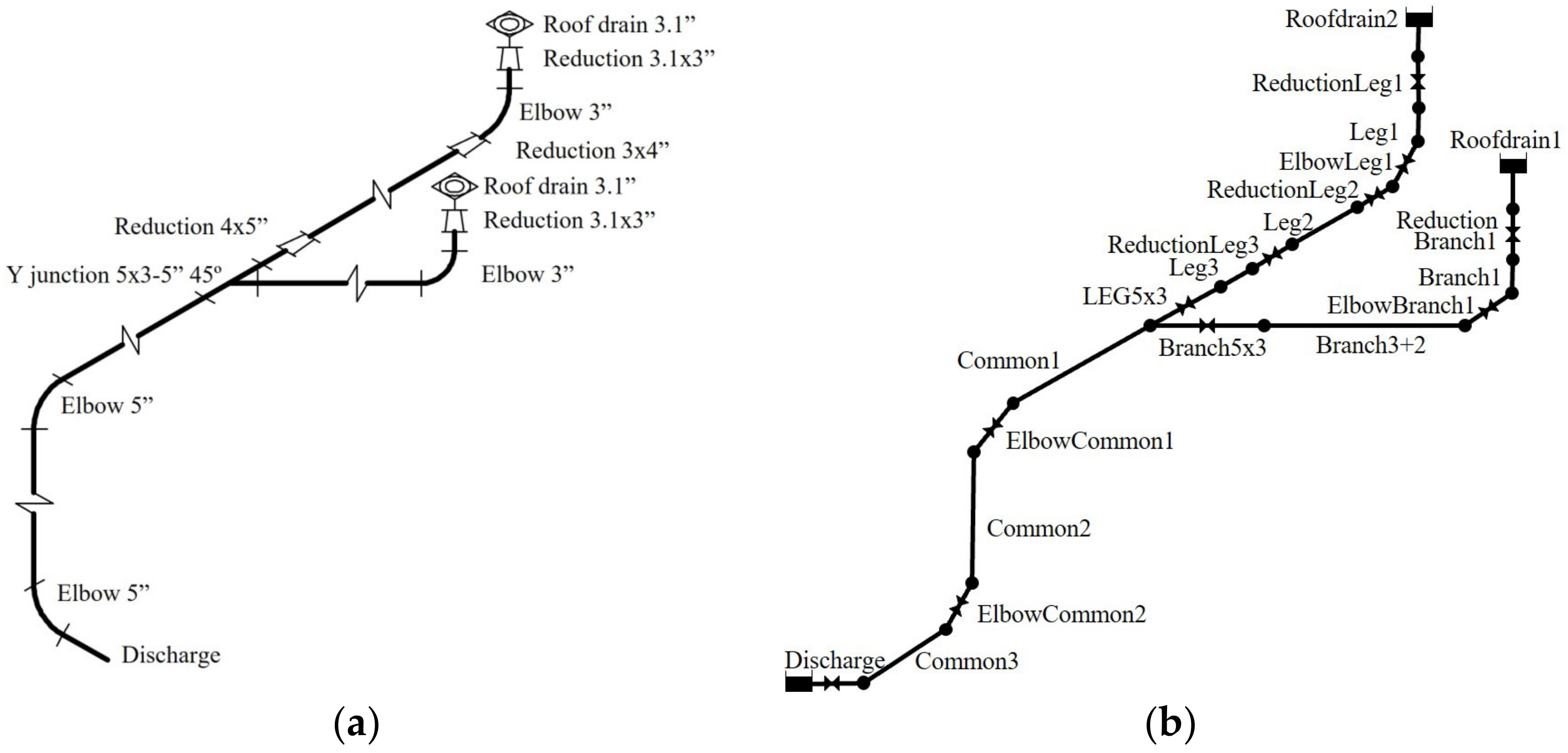Analysis of Siphonic Roof Drainage Systems with EPANET
Abstract
:1. Introduction
2. Materials and Methods
2.1. Experimental Equipment
2.2. Determination of Local Losses in the Elements of the System
2.3. System Model in EPANET
3. Results and Discussion
3.1. Experimental Test Results
3.2. Hydraulic Resistance of Elements Calculation
3.3. Experimental Results Validation
3.4. Software Validation
4. Conclusions
Author Contributions
Funding
Data Availability Statement
Conflicts of Interest
References
- Gormley, M.; Kelly, D.; Campbell, D.; Xue, Y.; Stewart, C. Building Drainage System Design for Tall Buildings: Current Limitations and Public Health Implications. Buildings 2021, 11, 70. [Google Scholar] [CrossRef]
- May, R.W.P. The Design of Conventional and Siphonic Roof-Drainage Systems. Water Environ. J. 1997, 11, 56–60. [Google Scholar] [CrossRef]
- Arthur, S.; Wright, G.B. Recent and future advances in roof drainage design and performance. Build. Serv. Eng. Res. Technol. 2005, 26, 337–348. [Google Scholar] [CrossRef]
- Fujimura, K.; Sakaue, K. Analysis of pneumatic pressure vibration affected by connecting WCs and discharge load types. Water 2017, 9, 6. [Google Scholar] [CrossRef] [Green Version]
- Arthur, S.; Swaffield, J.A. Siphonic roof drainage: Current understanding. Urban Water 2001, 3, 43–52. [Google Scholar] [CrossRef]
- Escarameia, M.; May, R.W.P. Performance of Siphonic Drainage Systems for Roof Gutters; HR Wallingford: Wallingford, UK, 1996. [Google Scholar]
- Guan, Y.; Fang, Z.; Tang, Z.; Yuan, J. Influence of the vent pipe diameter on the discharge capacity of a circuit vent building drainage system. Build. Serv. Eng. Res. Technol. 2019, 41, 5–24. [Google Scholar] [CrossRef]
- Banisoltan, S.; Rajaratnam, N.; Zhu, D.Z. Experimental and Theoretical Investigation of Vertical Drains with Radial Inflow. J. Hydraul. Eng. 2016, 143, 04016103. [Google Scholar] [CrossRef]
- Arthur, S.; Swaffield, J. Understanding Siphonic Rainwater Drainage Systems. In Proceedings of the CIB W62 Symposium Edinburgh, Water supply and Drainage for Buildings, Edinburgh, UK, 21–23 September 1999; pp. B1/1–B1/16. [Google Scholar]
- Lucke, T.; Beecham, S.; Qu, Y.Y. Estimating Flowrates Through Individual Outlets of Siphonic Roof Drainage Systems. Build. Res. Inf. 2016, 44, 289–300. [Google Scholar] [CrossRef]
- Beattie, R.K.; Jack, L.B. How siphonic roof drainage systems perform in a future climate. In Proceedings of the 2011 Symposium CIB W062, Aveiro, Portugal, 25–28 September 2011; pp. 301–307. [Google Scholar]
- Arthur, S.; Wright, G.B. Siphonic roof drainage systems-priming focused design. Build. Environ. 2007, 2, 2421–2431. [Google Scholar] [CrossRef]
- Lucke, T.; Arthur, S. Plastic pipe pressures in siphonic roof drainage systems. Build. Res. Inf. 2011, 39, 79–92. [Google Scholar] [CrossRef]
- Geberit Verwaltungs AG, Geberit Proplanner. Available online: https://www.geberit-global.com/planning-installation/geberit-proplanner/ (accessed on 25 May 2023).
- R. M. S. (RMS), SiphoniTec® Siphonic Roof Drain Sizing Software Information. Available online: https://www.jrsmith.com/siphonitec-siphonic-roof-drain-sizing-software-information (accessed on 25 May 2023).
- Siphonix Worldwide Ltd. Roof Drainge System. Available online: http://www.siphonix.com/software.html (accessed on 25 May 2023).
- Saint Gobain PAM. EPAMS Software. Available online: https://www.pam-drainage-solutions.com/rainwater-epams (accessed on 25 May 2023).
- Roland, R.E. Geberit ProPlanner 2020—Roof Drainage Systems; Training Manual; Geberit International AG: Rapperswil, Switzerland, 2020. [Google Scholar]
- Brkicbrkic, D. Iterative Methods for Looped Network Pipeline Calculation. Water Resour. Manag. 2011, 25, 2951–2987. [Google Scholar] [CrossRef] [Green Version]
- Wright, G.B.; Swaffield, J.A.; Arthur, S. Investigation into the performance characteristics of multi-outlet siphonic roof drainage systems. In Global Solutions for Urban Drainage; American Society of Civil Engineers: Reston, VA, USA, 2002; pp. 1–16. [Google Scholar] [CrossRef] [Green Version]
- Rossman, L. EPANET 2.0 Users Manual; U.S. Environmental Protection Agency: Washington, DC, USA, 2000.
- Chaudhry, M.H. Open-Channel Flow, 2nd ed.; Springer: New York, NY, USA, 2008. [Google Scholar]
- Todini, E.; Pilati, S. A gradient algorithm for the analysis of pipe networks. In Computer Applications in Water Supply: Volume 1—Systems Analysis and Simulation; Coulbeck, B., Orr, C.-H., Eds.; John Wiley & Sons: Hoboken, NJ, USA, 1988; pp. 1–20. [Google Scholar]
- Arthur, S.; Swaffield, J.A. Siphonic roof drainage system analysis utilising unsteady flow theory. Build. Environ. 2001, 36, 939–948. [Google Scholar] [CrossRef]
- May, R.W.P. Design Criteria for Siphonic Roof Drainage Systems; Report SR654; HR Wallingford: Wallingford, UK, 2004. [Google Scholar]
- Idelchik, I.E. Handbook of Hydraulic Resistance, 3rd ed.; Begell House Inc.: New York, NY, USA, 1996. [Google Scholar]




| Test | 1 | 2 | 3 | 4 | 5 | 6 | 7 | 8 | 9 |
|---|---|---|---|---|---|---|---|---|---|
| Water level (mm) | −68 | −67 | −124 | −55 | −83 | −83 | −83 | −82 | −80 |
| PM1 (mmwc) | −417 | −415 | −431 | −414 | −407 | −410 | −405 | −405 | −417 |
| PM2 (mmwc) | −572 | −573 | −577 | −563 | −561 | −557 | −562 | −563 | −558 |
| PM3 (mmwc) | −580 | −580 | −579 | −570 | −567 | −566 | −569 | −567 | −566 |
| PM4 (mmwc) | −724 | −724 | −723 | −722 | −722 | −722 | −722 | −723 | −724 |
| PM5 (mmwc) | −761 | −774 | −765 | −765 | −765 | −766 | −765 | −766 | −770 |
| Q (l/min) | 26.96 | 27.04 | 25.92 | 26.99 | 26.73 | 27.26 | 26.81 | 26.95 | 26.38 |
| Element | 1 | 2 | 3 | 4 | 5 | 6 | 7 | 8 | 9 | Mean |
|---|---|---|---|---|---|---|---|---|---|---|
| Roof sump | 1.71 | 1.68 | 1.57 | 1.78 | 1.56 | 1.48 | 1.52 | 1.51 | 1.73 | 1.61 |
| Elbow 1 | 1.17 | 1.18 | 1.19 | 1.12 | 1.18 | 1.08 | 1.20 | 1.19 | 1.10 | 1.17 |
| Elbow 2 | 1.13 | 1.12 | 1.22 | 1.19 | 1.23 | 1.20 | 1.20 | 1.22 | 1.23 | 1.19 |
| Discharge | 0.06 | −0.04 | 0.00 | 0.03 | 0.02 | 0.03 | 0.02 | 0.02 | −0.03 | 0.00 |
| Intake | PEPANET (Pa) | Pd (Pa) | Ps (Pa) |
|---|---|---|---|
| M1 | −216 | 1599 | −1814 |
| M2 | −932 | 1599 | −2531 |
| M3 | −1040 | 1599 | −2639 |
| M4 | −1942 | 1599 | −3541 |
| M5 | 1089 | 1599 | −510 |
| Intake | Ps,EPANET (Pa) | Ps,real (Pa) | Error (%) |
|---|---|---|---|
| M1 | −1814 | −1864 | 2.7 |
| M2 | −2531 | −2589 | 2.3 |
| M3 | −2639 | −2639 | 0.0 |
| M4 | −3541 | −3650 | 3.1 |
| M5 | −510 | −520 | 2.0 |
| SIPHONITEC Results | EPANET Results | |||||
|---|---|---|---|---|---|---|
| Flow (cfs) | Head in (ftwc) | Head out (ftwc) | Flow (cfs) | Head in (ftwc) | Head out (ftwc) | |
| Discharge | 1.634 | 2.342 | 0.000 | 1.637 | 2.350 | 0.000 |
| Common3 | 1.634 | 3.714 | 2.342 | 1.637 | 3.720 | 2.350 |
| ElbowCommon2 | 1.634 | 4.159 | 3.714 | 1.637 | 4.160 | 3.720 |
| Common2 | 1.634 | 6.490 | 4.159 | 1.637 | 6.490 | 4.160 |
| ElbowCommon1 | 1.634 | 6.799 | 6.490 | 1.637 | 6.800 | 6.490 |
| Common1 | 1.634 | 10.776 | 6.799 | 1.637 | 10.770 | 6.800 |
| LEG5x3 | 0.690 | 9.621 | 10.776 | 0.693 | 9.600 | 10.770 |
| Leg3 | 0.690 | 9.646 | 9.621 | 0.693 | 9.630 | 9.600 |
| ReductionLeg3 | 0.690 | 9.926 | 9.646 | 0.693 | 9.910 | 9.630 |
| Leg2 | 0.690 | 12.285 | 9.926 | 0.693 | 12.270 | 9.910 |
| ReductionLeg2 | 0.690 | 13.007 | 12.285 | 0.693 | 13.000 | 12.270 |
| ElbowLeg1 | 0.690 | 13.979 | 13.007 | 0.693 | 13.970 | 13.000 |
| Leg1 | 0.690 | 14.706 | 13.979 | 0.693 | 14.700 | 13.970 |
| ReductionLeg1 | 0.690 | 14.818 | 14.706 | 0.693 | 14.820 | 14.700 |
| RoofDrain2 | 0.690 | 15.267 | 14.818 | 0.693 | 15.270 | 14.820 |
| Branch5x3 | 0.944 | 15.269 | 10.776 | 0.944 | 15.280 | 10.770 |
| Branch3+2 | 0.944 | 16.691 | 15.269 | 0.944 | 16.700 | 15.280 |
| ElbowBranch1 | 0.944 | 18.511 | 16.691 | 0.944 | 18.520 | 16.700 |
| Branch1 | 0.944 | 19.866 | 18.511 | 0.944 | 19.870 | 18.520 |
| ReductionBranch1 | 0.944 | 20.075 | 19.866 | 0.944 | 20.080 | 19.870 |
| RoofDrain1 | 0.944 | 20.916 | 20.075 | 0.944 | 20.920 | 20.080 |
Disclaimer/Publisher’s Note: The statements, opinions and data contained in all publications are solely those of the individual author(s) and contributor(s) and not of MDPI and/or the editor(s). MDPI and/or the editor(s) disclaim responsibility for any injury to people or property resulting from any ideas, methods, instructions or products referred to in the content. |
© 2023 by the authors. Licensee MDPI, Basel, Switzerland. This article is an open access article distributed under the terms and conditions of the Creative Commons Attribution (CC BY) license (https://creativecommons.org/licenses/by/4.0/).
Share and Cite
López-Patiño, G.; Iglesias-Rey, P.L.; Martínez-Solano, F.J.; Fuertes-Miquel, V.S. Analysis of Siphonic Roof Drainage Systems with EPANET. Environments 2023, 10, 123. https://doi.org/10.3390/environments10070123
López-Patiño G, Iglesias-Rey PL, Martínez-Solano FJ, Fuertes-Miquel VS. Analysis of Siphonic Roof Drainage Systems with EPANET. Environments. 2023; 10(7):123. https://doi.org/10.3390/environments10070123
Chicago/Turabian StyleLópez-Patiño, Gonzalo, Pedro L. Iglesias-Rey, Francisco Javier Martínez-Solano, and Vicente S. Fuertes-Miquel. 2023. "Analysis of Siphonic Roof Drainage Systems with EPANET" Environments 10, no. 7: 123. https://doi.org/10.3390/environments10070123








